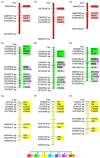Identification of COS markers specific for Thinopyrum elongatum chromosomes preliminary revealed high level of macrosyntenic relationship between the wheat and Th. elongatum genomes
- PMID: 30540828
- PMCID: PMC6291125
- DOI: 10.1371/journal.pone.0208840
Identification of COS markers specific for Thinopyrum elongatum chromosomes preliminary revealed high level of macrosyntenic relationship between the wheat and Th. elongatum genomes
Abstract
Thinopyrum elongatum (Host) D.R. Dewey has served as an important gene source for wheat breeding improvement for many years. The exact characterization of its chromosomes is important for the detailed analysis of prebreeding materials produced with this species. The major aim of this study was to identify and characterize new molecular markers to be used for the rapid analysis of E genome chromatin in wheat background. Sixty of the 169 conserved orthologous set (COS) markers tested on diverse wheat-Th. elongatum disomic/ditelosomic addition lines were assigned to various Th. elongatum chromosomes and will be used for marker-assisted selection. The macrosyntenic relationship between the wheat and Th. elongatum genomes was investigated using EST sequences. Several rearrangements were revealed in homoeologous chromosome groups 2, 5, 6 and 7, while chromosomes 1 and 4 were conserved. Molecular cytogenetic and marker analysis showed the presence of rearranged chromosome involved in 6ES and 2EL arms in the 6E disomic addition line. The selected chromosome arm-specific COS markers will make it possible to identify gene introgressions in breeding programmes and will also be useful in the development of new chromosome-specific markers, evolutionary analysis and gene mapping.
Conflict of interest statement
The authors have declared that no competing interests exist.
Figures






References
-
- Friebe B, Jiang J, Raupp WJ, McIntosh RA, Gill BS. Characterization of wheat-alien translocations conferring resistance to diseases and pests: current status. Euphytica. 1996; 91(1): 59–87. 10.1007/BF00035277 - DOI
-
- Fedak G. Alien species as sources of physiological traits for wheat improvement. Euphytica. 1985; 34(3): 673–680. 10.1007/BF00035403 - DOI
-
- Colmer TD, Flowers TJ, Munns R. Use of wild relatives to improve salt tolerance in wheat. J Exp Bot. 2006; 57(5): 1059–1078. 10.1093/jxb/erj124 - DOI - PubMed
-
- Murphy KM, Hoagland LA, Reeves PG, Baik BK, Jones SS. Nutritional and quality characteristics expressed in 31 perennial wheat breeding lines. Renew Agric Food Syst. 2009; 24(4): 285 10.1017/S1742170509990159 - DOI
-
- Ardalani S, Mirzaghaderi G, Badakhshan H. A Robertsonian translocation from Thinopyrum bessarabicum into bread wheat confers high iron and zinc contents. Plant Breed. 2016; 135(3): 286–290. 10.1111/pbr.12359 - DOI
Publication types
MeSH terms
Substances
LinkOut - more resources
Full Text Sources
Research Materials

